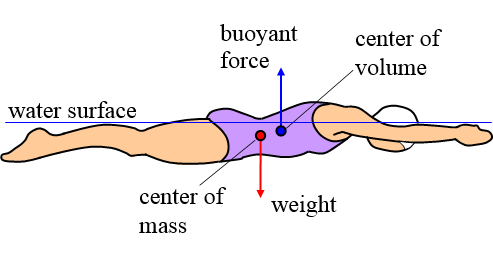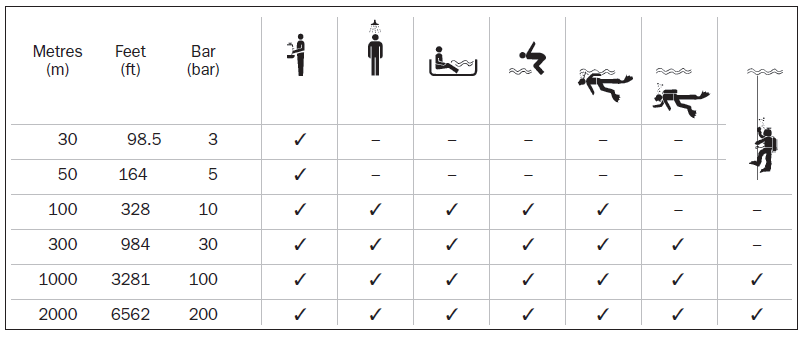Introduction
For swimming as a sports discipline, body buoyancy is one of the main physical variables that determine the body’s ability to stay on the surface of the water. Despite the fact that much attention is paid to training the strength and endurance of athletes, some aspects of physics are taken into account as fundamental natural laws that dictate the principles of preparation. The indicators of gravity, lifting force of water, specific gravity of a person, and other important parameters are those crucial criteria that explain the key principles of physical ability to move on the water. The ability to calculate all the necessary characteristics correctly to achieve the most effective result is an important aspect of sports swimming. The analysis of physical phenomena and laws makes it possible to understand the basic principles of holding and moving the body on the water and helps find optimal training strategies.
Basic Variables and Formulae
The main factors determining the technique of swimming are some physical laws, in particular, the laws of hydrostatics and hydrodynamics. Two basic forces act on the body of a person in the water in a static condition: gravity (bodyweight) directed downward and the lifting force of water acting upward. The latter is also called the buoyancy power and is one of the main variables that are to be taken into account. In Figure 1, the main forces involved in swimming are displayed (“Forces acting on a swimmer,” 2019).

In addition to buoyancy, other physical laws should also be taken into account. Since weight is a significant criterion determining the characteristic features of swimming, the Archimedes principle is to be considered. Espindola, Cena, Alves, Bozano, and Goncalves (2018) cite this law and give the formula that proves that buoyancy directly depends on the volume of the body immersed in the fluid. If buoyancy is displayed in the form of variable B, fluid density – ρ, g – the gravitational force, and V – the volume of a submerged body, the formula for calculating the buoyancy index will be as follows:
B = ρgV
Another important variable is water resistance that prevents free movement and requires efforts to move the body. Bejan (2016) compares the motion of a swimmer who makes hand movements with wearing gloves that push the fluid and allow staying on the surface. In Figure 2, the main resistance parameters are shown, and based on this infographics; one can note how much the water pressure differs at different depths (“Water resistance,” 2019).

When the swimmer moves with uniform speed, the general law of resistance of the aquatic environment may be expressed as an equation. Gatta, Cortesi, and Zamparo (2016) offer a formula that includes the basic variables for the calculation. As parameters, a streamlining coefficient depending on the shape of the human body and the viscosity of the fluid is used (C), water density (ρ), mid-section (S), and swimmer’s speed (V). The formula for calculating the resistance index (R) is as follows:
R=1/2*CρSV2
Using Physical Laws to Prepare Swimmers
In addition to the criteria of resistance and buoyancy, the individual characteristics of swimmers are to be taken into account in order to achieve the highest results of sports training. In particular, Bejan (2016) states that height and weight parameters are significant. The author cites the axiom that the first factor strengthens the second one (Bejan, 2016). As a result, the numerical indicators of these two parameters should be determined to prepare the necessary training program and develop a personal sports regime. The formula itself, which includes such variables as speed (V), acceleration (g – 9.8 m/s2), and height (L), is as follows:
V ~ (gL)1/2
Additional factors that partially affect physics and, at the same time, serve as important criteria for successful sports performances are techniques and sports uniforms. Alderson (2016) analyzes both these phenomena and notes that muscle kinetics is considered by many manufacturers of swimwear for athletes, which contributes to the most productive activity. Also, the author focuses on the styles of movement in the water and notes that modern technologies make it possible to assess the effectiveness of each of the four basic swimming techniques for an individual athlete (Alderson, 2016). This, in turn, helps calculate the optimal loads and tactics. Such tests are based on the physical characteristics of the movement of bodies in the water and contribute to finding successful training strategies.
To achieve excellent motor skills, the dimensions of tension and relaxation of various muscles and muscle groups should be established within the cycle of motion. As one trains, this cycle becomes stable, which contributes to high-performance sports results. According to Psycharakis and Yanai (2018), automated movements determine several crucial components, including speed (V), pace (N), and the swimmer’s length of swing (S). The numerical ratios of these parameters determine the speed of movement and depend on individual criteria. Accordingly, the formula for calculating the optimal swimming speed is as follows:
V = NS
Conclusion
The role of physics in swimming is significant, and the assessment of specific criteria allows developing optimal training strategies based on the calculations of swimmers’ individual parameters and taking into account the basic formulas. Resistance and buoyancy forces are key, and personal characteristics of athletes, such as height and weight affecting speed, are also used for analysis. Additional criteria, in particular, comfortable and functional swimwear and swimming technique, are related factors that are considered important.
References
Alderson, A. (2016). Sports tech swimming kit [Technology Swimming]. Engineering & Technology, 11(5), 76-77. Web.
Bejan, A. (2016). The physics of life: The evolution of everything. New York, NY: St. Martin’s Press.
Espindola, P. R., Cena, C. R., Alves, D. C. B., Bozano, D. F., & Goncalves, A. M. B. (2018). Use of an Arduino to study buoyancy force. Physics Education, 53(3), 035010. Web.
Forces acting on a swimmer [Image]. (2019). Web.
Gatta, G., Cortesi, M., & Zamparo, P. (2016). The relationship between power generated by thrust and power to overcome drag in elite short distance swimmers. PloS One, 11(9), e0162387. Web.
Psycharakis, S. G., & Yanai, T. (2018). How does buoyancy affect performance during a 200m maximum front crawl swim? Journal of Sports Sciences, 36(18), 2061-2067. Web.
Water resistance [Image]. (2019). Web.